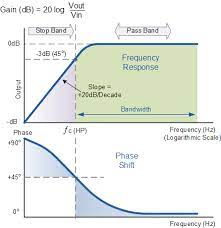High-pass filter is an electronic filter that passes signals with a frequency higher than a certain cutoff frequency and attenuates signals with frequencies lower than the cutoff frequency. The amount of attenuation for each frequency depends on the filter design.
A high-pass filter is usually modeled as a linear time-invariant system. It is sometimes called a low-cut filter or bass-cut filter in the context of audio engineering. High-pass filters have many uses, such as blocking DC from circuitry sensitive to non-zero average voltages or radio frequency devices. They can also be used in conjunction with a low-pass filter to produce a band-pass filter.
In the optical domain filters are often characterized by wavelength rather than frequency. High-pass and low-pass have the opposite meanings, with a “high-pass” filter (more commonly “long-pass”) passing only longer wavelengths (lower frequencies), and vice versa for “low-pass” (more commonly “short-pass”).
In optics a high pass filter is a transparent or translucent window of colored material which allows light longer than a certain wavelength to pass through and attenuates light of shorter wavelengths. Since light is often measured not by frequency but by wavelength, which is inversely related to frequency, a high pass optical filter, which attenuates light frequencies below a cutoff frequency, is often called a short-pass filter; it attenuates longer wavelengths.
What is the use of high pass filter ?
On the simplest level, a high-pass filter is just a filter (sometimes call as low-cut) that attenuates low frequencies below a certain cutoff frequency and allows frequencies above to pass.
What does we remove high pass filter ?
An audio high pass filter (HPF) is an equalization tool that attenuates all frequencies below a set point. In other words, high pass filters remove low frequencies while allowing high frequencies to pass through. They are using in almost every application of audio technology.
What is the best frequency for high pass filter?
A cutoff frequency of 80 Hz with −12 dB/octave is a common setting for high-pass filters because of the infamous 50-60 Hz hum that often finds its way into audio signals. The C 414 high-pass filters effectively remove low-end rumble and noise while maintaining the integrity of the signal’s frequencies above the cutoff.
What is RL high pass filter?
An RL circuit acts as a high pass filter when constructed as shown in figure. In the circuit shown, the resistor is the series component and the inductor is the shunt component. If the input frequency to the circuit increases, the reactance of the inductor increases until the component effectively acts as an open.
Should I pass everything all high?
Bad mixing tip number one is you should always high-pass every track in your mix but the kick or the bass. Now this is the idea that in the beginning of the mixing process we should apply a high-pass filter across our entire mix to every track except maybe the kick or the bass without even listening.
How is the high pass form higher order filter ?
High pass filter are often form for interchanging frequency determining resistors and capacitors in low pass filters. For example, a first order high pass filter is form from a first order low pass filter by inter changing components R and C.
How do you set a high pass frequency?
Adjust the crossover frequency control to the lowest setting (this is usually around 50Hz for most amps). Using a small screwdriver, turn it up slightly – about 1/8 of a turn. This should be around the 60-70Hz range.
What is the high pass filter in Photoshop?
There are plenty of ways you can sharpen an image. But Photoshop CC’s High Pass filter is favor for being non-destructive. The filter identifies the outline/edges of an image. And when paired with a blending mode that increases contrast, will appear to sharpen it.
Where can I get high pass vocals?
Start the high pass quite low, around 70Hz. And gradually move it up the frequency spectrum until you start to hear it making the vocal sound thinner. This will usually be somewhere between 120Hz – 200Hz. Once you hear it thinning out the vocal you know you’ve gone too far.
What is a high shelf filter?
A shelving filter, also referred to as a shelf filter, shelf EQ, shelving EQ etc. allows you to boost. Or attenuate either the high end or the low end of the frequency spectrum. A shelving filter which boosts or attenuates the high end of the frequency spectrum is call as a ‘high shelf’.





